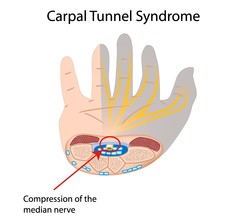

What is the Carpal Tunnel?
The Carpal Tunnel is located in the wrist. The bottom and sides of the tunnel are formed by the wrist (carpal) bones. The transverse carpal ligament is a strong band of connective tissue that forms the top of the tunnel. The carpal tunnel protects a major nerve, as well as the tendons that bend the fingers and thumb.

What is Carpal Tunnel Syndrome?
Carpal Tunnel Syndrome is caused by the compression of the median nerve that travels through the carpal tunnel. People with this condition may experience numbness, pain or tingling in the hand, usually in the thumb, index and long fingers. Symptoms may come and go or be constantly present. Activities using the hand may become difficult, such as buttoning a shirt. If the condition continues to worsen, strength may decrease in the hand.
What are Common Causes?
Some causes and factors of Carpal Tunnel Syndrome include heredity, age and medical conditions such as rheumatoid arthritis and diabetes.
Diagnosis and Examination
History and physical exam by a qualified musculoskeletal expert is the first step. Nerve testing may be ordered. In addition, a doctor will examine your ability to perform certain hand physical tasks.
Common Treatments
Treatments for Carpal Tunnel Syndrome include non-surgical and surgical treatment. If untreated, the condition often worsens.
Recovery
Patients can resume light activities soon after surgery. Most patients’ symptoms improve after surgery but recovery may be gradual. Some patients may benefit from hand therapy to help improve function.
Copyright © www.orthopaedics.win Bone Health All Rights Reserved